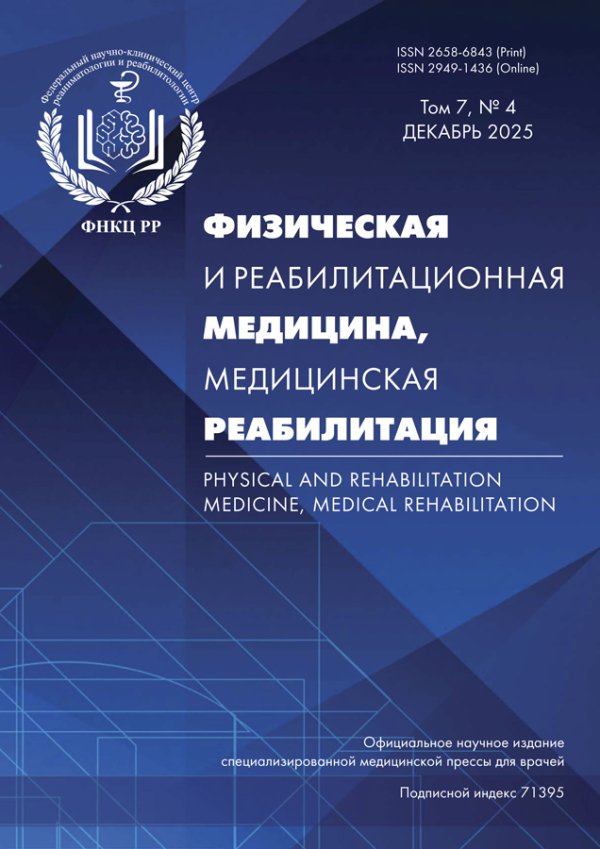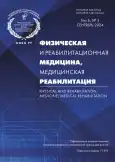Noninvasive ventilation outside the intensive care unit for respiratory rehabilitation after on-pump cardiac surgery: a prospective randomized controlled trial
- Authors: Dvoryadkin A.A.1, Polyakov D.A.1, Belyakova E.V.1, Protsenko D.N.2,3, Krichevskiy L.A.1,4
-
Affiliations:
- Moscow City Hospital named after S.S. Yudin
- Moscow Multidisciplinary Clinical Center "Kommunarka"
- The Russian National Research Medical University named after N.I. Pirogov
- Russian Medical Academy of Continuous Professional Education
- Issue: Vol 6, No 3 (2024)
- Pages: 220-229
- Section: ORIGINAL STUDY ARTICLE
- URL: https://journal-vniispk.ru/2658-6843/article/view/269349
- DOI: https://doi.org/10.36425/rehab633051
- ID: 269349
Cite item
Full Text
Abstract
BACKGROUND: Сardiac surgery with cardiopulmonary bypass is associated with a high risk of postoperative respiratory complications. Perioperative damage to the lungs caused by ischemia and reperfusion, mechanical ventilation, trauma, etc., is a trigger for aseptic inflammation in the lungs, and it makes compromised lungs an easy target for infection. Actively developed methods of protecting the lungs, such as lung-protective ventilation, are limited to the perioperative and resuscitation stages and do not exhaust the entire range of respiratory support required in the later stages of postoperative hospitalization. This indicates the need for methods of respiratory rehabilitation following transfer from the intensive care unit.
AIM: To evaluate the effectiveness of respiratory rehabilitation using noninvasive mask lung ventilation performed outside the intensive care unit in cardiosurgical patients compared to standard breathing exercises.
MATERIALS AND METHODS: This prospective, randomized, single-center study included 60 patients aged 62±12 years who underwent cardiac surgery with cardiopulmonary bypass (86±17 min) with bypass grafting of 2±1 coronary arteries and required mechanical lung ventilation for more than 6 hours following surgery. After transfer from the intensive care unit, patients in the control group (n=30) underwent standard respiratory rehabilitation, and those in the main group (n=30) additionally received four sessions of noninvasive mask lung ventilation.
RESULTS: The patients in the main group had a more rapid respiratory function recovery and, thus, reduced postoperative hospitalization time (10 [8; 15]) compared to those in the standard group (14 [13; 20]).
CONCLUSION: The use of noninvasive mask lung ventilation outside the intensive care unit along with the standard respiratory activation protocol is safe and speeds up respiratory rehabilitation and reduces postoperative hospitalization of patients after coronary bypass surgery.
Full Text
##article.viewOnOriginalSite##About the authors
Artem A. Dvoryadkin
Moscow City Hospital named after S.S. Yudin
Author for correspondence.
Email: artyom_dvoryadkin@mail.ru
ORCID iD: 0000-0002-1595-8663
SPIN-code: 3886-5065
Russian Federation, 4 Kolomensky proezd, 115446 Moscow
Dmitry A. Polyakov
Moscow City Hospital named after S.S. Yudin
Email: Dmitri_polyakov@bk.ru
ORCID iD: 0000-0002-0334-4138
Russian Federation, 4 Kolomensky proezd, 115446 Moscow
Ekaterina V. Belyakova
Moscow City Hospital named after S.S. Yudin
Email: dr.belyakova.e.v@gmail.com
ORCID iD: 0009-0003-7196-0535
Russian Federation, 4 Kolomensky proezd, 115446 Moscow
Denis N. Protsenko
Moscow Multidisciplinary Clinical Center "Kommunarka"; The Russian National Research Medical University named after N.I. Pirogov
Email: drprotsenko@me.com
ORCID iD: 0000-0002-5166-3280
SPIN-code: 1019-8216
MD, Dr. Sci. (Medicine), Professor
Russian Federation, 8/3, Sosensky Stan st., 142770 Moscow; 1 street Ostrovityanova, 117997 MoscowLev A. Krichevskiy
Moscow City Hospital named after S.S. Yudin; Russian Medical Academy of Continuous Professional Education
Email: levkrich72@gmail.com
ORCID iD: 0000-0001-8886-7175
SPIN-code: 7835-0136
MD, Dr. Sci. (Medicine), Professor
Russian Federation, 4 Kolomensky proezd, 115446 Moscow; 2/1, building 1, Barrikadnaya st., 123242 MoscowReferences
- Rybka MM. Ischemia/reperfusion and microcirculation disorder in lungs. Russ J Thoracic Cardiovascular Surg. 2016;58(3):130–135. EDN: UFUPJK
- Naveed A, Azam H, Murtaza HG, et al. Incidence and risk factors of pulmonary complications after cardiopulmonary bypass. Pak J Med Sci. 2017;33(4):993–996. doi: 10.12669/pjms.334.12846
- Kozlov IA, Romanov AA. Respiratory biomechanics, intrapulmonary water, and pulmonary oxygenizing function during uncomplicated operations under extracorporeal circulation. General Reanimatol. 2007;3(3):17. EDN: IBZICZ doi: 10.15360/1813-9779-2007-3-17
- Kamenskaya OV, Loginova IY, Klinkova AS, et al. Chronic obstructive pulmonary disease and miocardial revascularisation outcomes: Relationship with self-reported quality of life. Pulmonologiya. 2022;32(6):854–861. EDN: WFDSSZ doi: 10.18093/0869-0189-2022-32-6-854-861
- Gabriel EA, Locali FR, Matsuoka KP, et al. Lung perfusion during cardiac surgery with cardiopulmonary bypass: Is it necessary? Interact Cardiovasc Thorac Surg. 2008;7(6):1089–1095. doi: 10.1510/icvts.2008.184275
- Lugovskaya NM, Panfilov DS, Maksimov AI, et al. Comprehensive lung protection during circulatory arrest in aortic arch surgery. Siberian J Clin Exp Med. 2021;36(1):109–117. EDN: UBLLRV doi: 10.29001/2073-8552-2021-36-1-108-116
- Buggeskov KB, Wetterslev J, Secher NH, et al. Pulmonary perfusion with oxygenated blood or Custodiol HTK solution during cardiac surgery for postoperative pulmonary function in COPD patients: A trial protocol for the randomized, clinical, parallel group, assessor and data analyst blinded pulmonary protection trial. Trials. 2013;14:30. doi: 10.1186/1745-6215-14-30
- Maltesen RG, Buggeskov KB, Andersen CB, et al. Lung protection strategies during cardiopulmonary bypass affect the composition of bronchoalveolar fluid and lung tissue in cardiac surgery patients. Metabolites. 2018;8(4):54. doi: 10.3390/metabo8040054
- Rong LQ, di Franco A, Gaudino M. Acute respiratory distress syndrome after cardiac surgery. J Thorac Dis. 2016;8(10):1177–1186. doi: 10.21037/jtd.2016.10.74
- Krichevsky LA, Rybakov VYu, Dvoryadkin AA, Protsenko DN. Systemic inflammatory response in cardiac surgery. Russ J Anesthesiol Reanimatol. 2021;(3):94-102. EDN: YGITBG doi: 10.17116/anaesthesiology202103194
- Karpun NA, Moroz VV, Afonin AP, et al. Acute transfusion-associated lung injury in cardiosurgical patients. General Reanimatol. 2008;(3):23–29. EDN: JTZVFP doi: 10.15360/1813-9779-2008-3-23
- Pshenichniy TA, Akselrod BA, Titova IV, et al. Use of protective lung ventilation regimen in cardiac surgery patients. Russ J Anesthesiol Reanimatol. 2016;61(3):189–195. EDN: WBKTBB doi: 10.18821/0201-7563-2016-3-189-195
- Kozlov IA, Romanov AA. Alveolar opening maneuver (mobilization) in intraoperative pulmonary oxygenizing dysfunction in cardiosurgical patients. Russ J Anesthesiol Reanimatol. 2007;(2): 27–31. EDN: IATWTL
- Pelosi P, Rocco PR, Gama de Abreu M. Close down the lungs and keep them resting to minimize ventilator-induced lung injury. Crit Care. 2018;22(1):72–80. EDN: OVRDAE doi: 10.1186/s13054-018-1991-3
- Oravec N, King MA, Spencer T, et al. Barriers to successful discharge after cardiac surgery: A focus group study and cross-sectional survey. Seminars Thoracic Cardiovascular Surg. 2023;35(4):675–684. EDN: ZTQUJO doi: 10.1053/j.semtcvs.2022.07.003
- Zagorodnyaya TV, Korniyenko AN, Ketskalo MV. Respiratory therapy for acute respiratory distress syndrome in cardiosurgical patients. General Reanimatol. 2005;1(5):65–68. EDN: IFAHXL doi: 10.15360/1813-9779-2005-5-65-68
- Yaroshetskiy AI, Vlasenko AV, Gritsan AI, et al. Non-invasive respiratory support (the second edition). Clinical guidelines of the federation of anesthesiologists and reanimatologists of Russia. Russ J Anаеsthesiol Reanimatol. 2019;(6):5–19. EDN: QCGIRZ doi: 10.17116/anaesthesiology20190615
- Yeremenko AA, Levikov DI, Yegorov VM, et al. Use of lung opening maneuver in patients with acute respiratory failure after cardiosurgical operations. General Reanimatol. 2006;2(1):23–28. EDN: ICIMSL doi: 10.15360/1813-9779-2006-1-23-28
- Bellani G, Grasselli G, Cecconi M, et al. Noninvasive ventilatory support of patients with COVID-19 outside the Intensive Care Units (WARd-COVID). Ann Am Thorac Soc. 2021;18(6):1020–1026. doi: 10.1513/AnnalsATS.202008-1080OC
- Zabolotskikh IB, Kirov MY, Lebedinskii KM, et al. Anesthesia and intensive care for patients with COVID-19. Russian Federation of anesthesiologists and reanimatologists guidelines. Annals of critical care. Alexander Saltanov Intensive Care Herald. 2022;(1):9–143. EDN: BVMRHN doi: 10.21320/1818-474X-2021-S1-9-143
- Goeddel LA, Hollander KN, Evans AS. Early extubation after cardiac surgery: A better predictor of outcome than metric of quality? J Cardiothoracic Vascular Anesthesia. 2018;32(2):745–747. doi: 10.1053/j.jvca.2017.12.037
- Olper L, Cabrini L, Landoni G, et al. Non-invasive ventilation after cardiac surgery outside the intensive care unit. Minerva Anestesiol. 2011;77(1):40–45.
- Jaber S, Jung B. Postoperative non-invasive ventilation outside the ICU: Do not go too far! Minerva Anestesiol. 2011;77(1):9–10.
- Cabrini L, Moizo E, Nicelli E, et al. Noninvasive ventilation outside the intensive care unit from the patient point of view: A pilot study. Respir Care. 2012;57(5):704–709. doi: 10.4187/respcare.01474
Supplementary files










